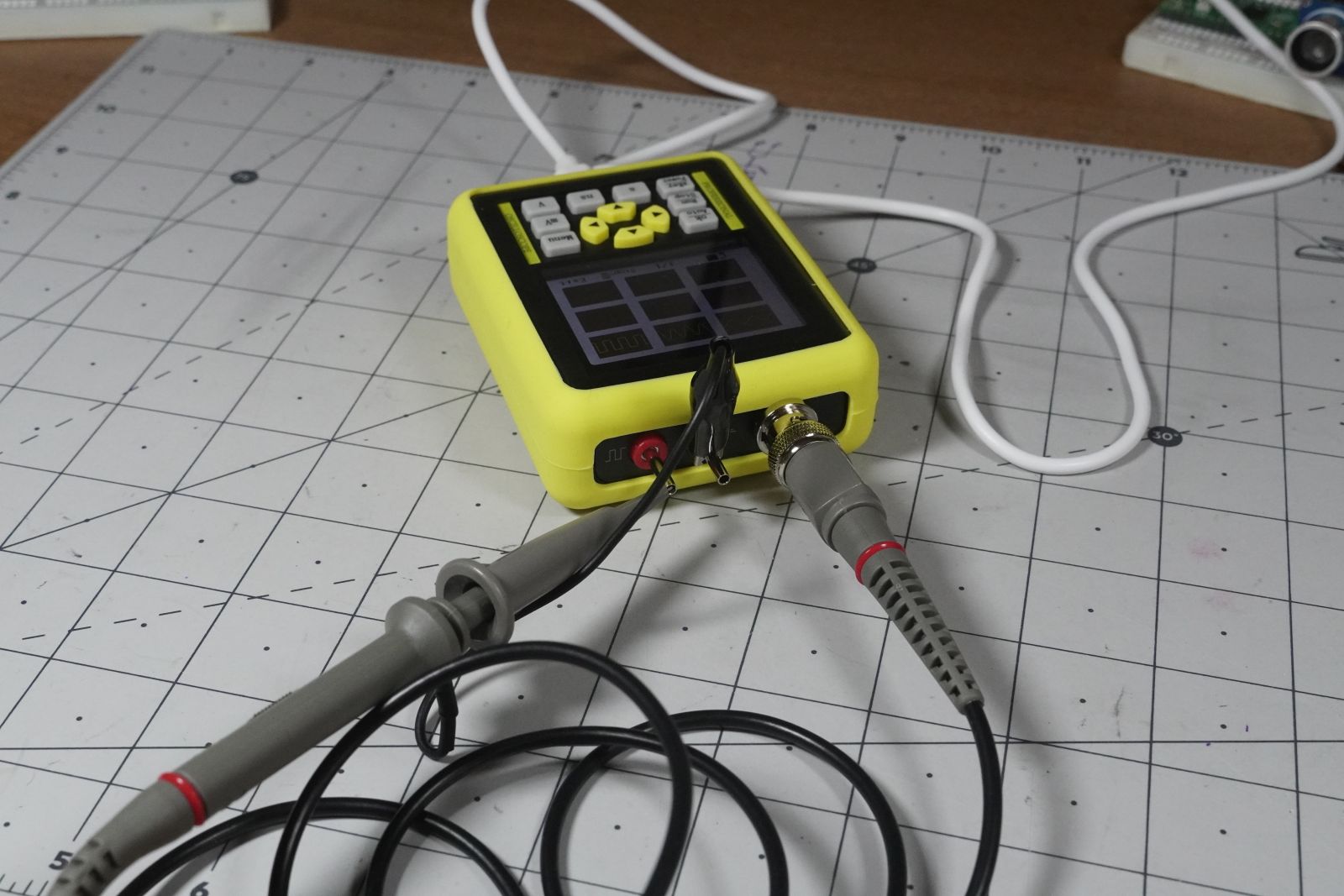Budget Tools Review: DSO1511G Digital Oscilloscope from ZEEWEII
March 17, 2023
Video
In this latest Budget Tools Review, I’ve had the pleasure of trying out the ZEEWEII DSO1511G single-channel oscilloscope and signal generator. These units can be had for around $60 from the usual suspects (Amazon, eBay, AliExpress, et al).
First Impressions: Small, but Powerful
As seen in the unboxing/review video, the device came packaged in a nice storage case, with all accessories and the manual inside. At 72 x 107 x 32mm it qualifies as handheld, though its 32mm thickness might make you think twice about stuffing it into your pants pocket. The ZEEWEII DSO1511G is well-built, with no noticeable cosmetic defects on my unit, and a rubber outer enclosure that should soften any bumps.
The package included a 1/10x probe, USB A-to-C cable, A/V cable, and an accessories pack with a stick-on stand and testing pins. Turning it on, menu selections are quick and responsive, and after a few minutes of tinkering and skimming the manual, navigation was refreshingly straightforward.
Scope Stats:
The scope’s listed stats are rather impressive, potentially beating out the OWON HDS2xx models reviewed earlier (HDS2102S and HDS242) in some aspects.
- Bandwidth: 120MHz
- Sample Rate: 500 Msa/s (only single channel)
- Storage Depth: 128 Kbit
- Signal generator
While it’s only a single-channel scope, it does allow you to save a signal as a reference for comparison with live data. You can also save waveforms as images, which can then be transferred to a computer via USB. Finally, its signal generator is a nice feature for a device in this price range.
Caption: Currently generated signal in yellow, reference waveform in red. (Image Credit: Jeremy Cook)
How Much Waveform Storage?
Taking all of this at face value, one thing that really pops out at first glance is 128 Kbit storage depth. Numerically, this appears to be 16 times greater than the OWON HDS2xx devices, which list 8K of storage. Upon further examination, it would seem that OWON lists the number of samples (8,000), while the ZEEWEII lists the total memory dedicated to samples (128,000 bits). Multiply the OWON HDS2xx’s 8,000 samples by its 14-bit vertical resolution and you get 112,000 bits or storage.
Working this out from the other direction, ZEEWII lists measurement as “14 types,” which I suspect indicates 14 bits, thus 9,000 samples and some change. Subtract out bit of storage overhead, and the scope is spec’d the same as the OWONs, or nearly so. Feel free to ping me on Twitter or sound off in the comments if you have another read on this.
Special Feature: AV Output (YMMV)

Caption: Adrian was impressed with this video output ability. (Image Credit: Screencap of linked demo video – Adrian’s Digital Basement)
In July of 2020, I published a video outlining how I put together a Digilent Analog Discovery 2 device with a Raspberry Pi and some other electronics in order to show images from a guitar’s output on a projector screen. While there were probably easier ways to do that, this was a rather involved setup that cost somewhere in the order of $500. With this little scope you could, in theory, get your waveform up on the big screen for a fraction of that price.
.jpg)
My results were not as good. (Image Credit: Jeremy Cook)
Unfortunately, while I was quite excited about this feature, it seems that my 10+ year old Panasonic TV does not agree with the DSO1511G’s analog RCA-style output. Instead of the nice crisp(?) 320 x 240 display demonstrated here, I was treated to a black-and-white signal that appears to be out of sync with the TV’s timing. While this could be ideal for presentation purposes, you’d want to test and provide your own TV/projector, as there’s no guarantee it would work with on-site equipment.
Bottom Line: Worth Purchasing?
The ZEEWEII DSO1511G is an extremely portable scope. Combined with its rugged design, battery power, and signal generator, it could be a perfect travel companion within its limitations. The friendly interface functionality should make it appropriate for those just learning electronics, as well as those with more experience and that would like to get up and running quickly.
In addition to those features, its low cost means that if you drop/loose/break/fry a unit, you can probably afford to buy another. You could even carry multiples of the unit for backup, or even as a sort of ad hoc multi-channel analysis setup. If its specs are appropriate for your use cases, I would definitely say it’s worth consideration.







